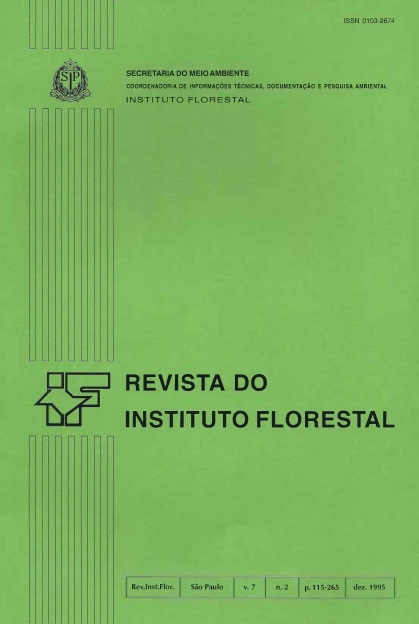ECOLOGIA DA POLINIZAÇÃO DE Genipa americana L. (RUBIACEAE) NA ESTAÇAO ECOLÓGICA DE MOJl-GUAÇU, ESTADO DE SAO PAULO
DOI:
https://doi.org/10.24278/2178-5031.199572705Abstract
The floral biology and the breeding system of Genipa americana L. (Rubiaccac) woody plant that takcs on the margin of gallery forests along the rivers of the country of São Paulo, were studied "in situ", in a place named "Mata da Figueira", belonging to thc Moji-Guaçu (SP) Ecological Station (22° 18' S; 470. 10' W). The methodology consisted in the characterization of the specics in its morphology and floral events, its functional changings and means of attraction, the study of the floral visitors during the anthesis and lhe determination of its breeding system. By the observation and experiments, it was noticed that the specics presents dioccy, diurnal anthesis, being mellitophilc and pollinated by large bees, Bambus mono and Epicharis rustica flava. As to the breeding system the results showed the occurrence of allogamy and apomoxis as over placed systems.
Downloads
References
APP ANAH, S. 1981. Pollination in Malaysian primary forest. Malaysian Forest Longman, Kuala Lampur, 44:33-42.
ARRUDA, V. L. V. & SAZIMA, M. 1988. Polinização e reprodução de Celtis iguanae (Jacq.) Sarg. (Ulmaceae), uma espécie anemófila. Rev. Bras. Bot., São Paulo, 11:113-122.
BAWA, K. S. 1974. Breeding systems of trees species of a lowland tropical community. Evolution, Seattle, 28:85-92.
___ . & BEACH, J. H. 1983. Self - incompatibility systems in the Rubiaceae of a tropical lowland wet forest. Am. J. Bot., Oklahoma, 70(9): 1281-1288.
___ & OPLER, P. A 1975. Dioecism in tropical forest trees. Evolution, Seattle, 29: 167-179.
___ et aL Reproductive biology of tropical lowland rain forest trees. II. Pollination systems. Am. J. of Bot., Oklahoma, 72(3):346-356.
BRAGA, R. 1976. Plantas do Nordeste, especialmente do Ceará. 3ed. Fortaleza, Ed. Universitária/UNRN. 540 p.
___ O ESTADO DE SÃO PAULO. 1991. Jenipapo faz bem até ao gado. O Estado de São Paulo, São Paulo, ( 1842): 11.
FONSECA, H. & ARZOLLA, J. D. P. 1965. Cromatografia de açúcares. Boletim Didático, Piracicaba, (7): 1-20.
FRANKIE, G. W.; BAKER, H. G. & OPLER, P. A 1974. Comparative phenological studies of trees in tropical wet and dry forest in the lowland of Costa Rica. Journal of Ecology, London, 62(3):881-919.
___ . & HABER, W. A 1983. Why bees move among mass-flowering neotropical trees. ln: JONES, C. E. & LITTLE, R. J. (ed.). Handbook of experimental pollínation biology. New York, Van Nostrand Runhold Co. p. 360-372.
___ .; OPLER, P. A & BAWA, K. S. 1976. Foraging behavior of solitary bees: implications for outcrossing of a neotropical forest tree species. J. Eco/., London, 64: 1049-1057.
____ . et a/. 1983. Characteristics and organization of the large bee pollination systems in the Costa Rican dry forest. In: JONES, C. E. & LITTLE, R. J. (ed.). Handbook of experimental pollination biology. New York, Van Nostrand Runhold Co. p. 410-446.
HALLÉ, F.; OLDEMAN, R. A A & TOMLINSON, P. B. 1978. Tropical trecs and forcsts: an architectural analysis. New York, Springer-Verlag. 44lp.
HEYWOOD, V. H. 1970. Taxonomia vegetal São Paulo, Nacional, USP. 108p. (Estudos de Biologia, v. 5)
HOEHNE, F. C. 1949. Frutas Indígenas. São Paulo, Instituto de Botânica. 88p. (Publicação, 2) JANZEN, D. H. 1967. Synchronization of sexual reproduction of trees within the dry season in Central America. Evolutíon, Seattle, 21 (3):620-637.
JONES, C. E. & LITTLE, R.J. (eds.) 1983. Handbook of experimental pollínation biology. New York, Van Nostrand Reinhold Co. 558p.
KAGEY AMA, P.Y. & CASTRO, C. F. A 1990. Matas ciliares: pesquisas em desenvolvimento. ln: CONGRESSO DA SOCIEDADE BOTÂNICA DE SÃO PAULO, 8, Campinas-SP. Resumos... p. 26.
KAUR, A. et ai. 1978. Apomixis may be widespread among trees of the climax forest. Nature, London, 271:440-442.
KORNERUP, A. & W ANSCHER, J. H. 1963. Taschenlexikon der Farben. Kopenhagen, Sadolin & Holmblad NS.
MELLO, E. C. 1971. Estudo dendrológico e determinação das características físicas e mecânicas do jenipapo - Genipa americana L. Brasil Florestal Rio de Janeiro, I (8): 17-20.
PEREIRA, H. 1919. Apontamentos sobre madeiras do Estado de São Paulo. 6cd. São Paulo, Secretaria da Agricultura, Comércio e Obras Públicas. 160p.
RADFORD, A. E. et ai. 1974. Vascular plant systemalics. New York, Harper & Row, New York Press. 263p.
RIZZINI, C. T. & MORS, W. B. 1976. Botânica econômica brasileira EDUSP/USP. 207p. São Paulo.
SILBERBAUER-GOTTSBERG ER, GOTTSBERGER, G. 1975. sphingophile angiospermen brasiliens. Syst. Evol., London, 123:157-164. 1. & Über
Plant.
VOGEL, S. 1983. Ecophysiology of zoophilic pollination. ln: LANGE, O. L. et ai. (eds.). Physiological plant ecology III. Berlin, Springer-Verlag. p. 560-612.
XAVIER, M. & XAVIER, A. T. T. N. 1976. Jenipapeiro: uma espec1e indígena para reflorestar. Cerrado, Brasília, (34):20-23.
ZEISLER, M. 1938. Über dic Abgrcnzung der eigentlichen Narbenllche mil Hilfc von Reaktionem. Beih. Bot. Zbl., 58:308-18.
















